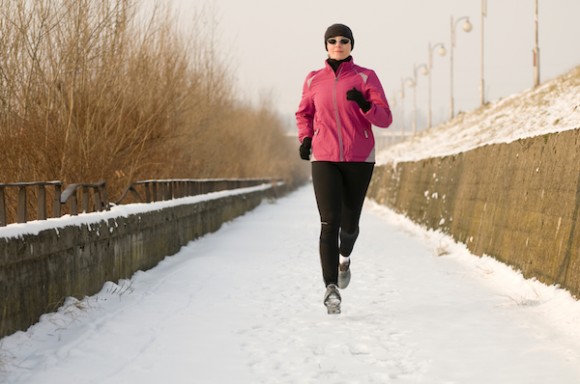As the mercury continues its seasonal plunge, it’s easy to get out of your workout routine. It’s warm and toasty inside, and besides what’s a couple extra pounds during sweater weather, right? We all know better. Fitness is just as important during winter as it is the rest of the year, but there are some extra precautions you should take to ensure your outdoor workout is safe. Follow these tips and you won’t have to play catch up when spring arrives.
1. Consult your doctor
Systems of the body respond differently during really cold weather. If you have an existing medical condition like heart problems or asthma, talk to your doctor before exercising outdoors. She may recommend a change in your medication schedule or a limit on your amount of exercise. You should also wear a medical alert bracelet just in case something happens and you’re incapable of explaining these medical conditions to first responders.
2. Layers are your friends
As strange as it may sound, sweat is the enemy when it comes to a healthy winter workout. The combination of chilly temperatures and moisture on your skin can make you that much colder. A single bulky jacket doesn’t provide enough flexibility as exercise heats your body and you start to sweat. Wear multiple layers that you can take off as you heat up and put back on as your body cools. The layer closest to your skin should be a material that draws moisture away, like polypropelene thermal gear.
3. Don’t forget to drink fluids
You need to stay hydrated in the winter just as you do during warmer months. People often overlook the need for fluids during cold weather workouts because the degree to which you’re sweating may be less noticeable under those layers. Drink water or sports drinks before, during and after your workout. Signs of dehydration can include dry or sticky mouth, low urine output, weakness or dizziness. If you experience any of these, discontinue your workout and get some fluids in your body quickly.
4. Protect your extremities
When it’s cold out, your body automatically focuses blood flow on your core. It’s a defense mechanism to ensure the body’s main organs are sustained above all else. Unfortunately, that leaves your fingers, ears, nose and toes at increased risk for discomfort and potential damage. Wear gloves to keep your hands warm and thermal socks to care for your feet. You should also wear a thermal hat to protect your ears and prevent body heat from escaping through your head. A scarf or winter mask is great for covering your mouth and nose and also help warm the air you breathe in.
5. Know the warning signs
The biggest risks of working out in the cold are frostbite and hypothermia. Frostbite occurs when body tissues are exposed to extreme cold for an extended period of time. Watch out for feelings of numbness or stinging sensations. Hypothermia occurs when your core body temperature drops below 95 degrees. Early symptoms include slurred speech, intense shivering and loss of coordination. Both of these conditions are very harmful and should be attended to immediately. Get inside and warm your body slowly. If any of these symptoms persist, seek medical attention.
Author Profile: Stacie Burns is a freelance writer for Hope Paige, designer of fashionable medical ID jewelry. In her spare time, Stacie enjoys working out, reading and traveling.







